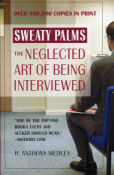| What REALLY goes on in a job interview? Find out in the new revision of "Sweaty Palms: The Neglected Art of Being Interviewed" (Warner Books) by Tony Medley, updated for the world of the Internet . Over 500,000 copies in print and the only book on the job interview written by an experienced interviewer, one who has conducted thousands of interviews. This is the truth, not the ivory tower speculations of those who write but have no actual experience. "One of the top five books every job seeker should read," says Hotjobs.com. | |
|
The Great Raid (10/10) by Tony Medley Several years ago I read “The Great Raid on Cabanatuan” by William B. Breuer. I thought how wonderful it would be if someone made a movie out of it because it shows heroic Americans and Filipinos and bestial Japanese, but I didn’t hold my breath. Well, Miramax has made it! While it barely mentions the Bataan Death March, it does tell, in detail, the courageous, heroic efforts of the U.S. Army and Filipino commandos to liberate the notorious POW camp in the Philippines called Cabanatuan, which held some of the few survivors of the Death March and the subsequent three years of horrific imprisonment by the Japanese savages (when you see them in this movie, you’ll know what I mean). Just as an example, when the Japanese learned of McArthur’s landing in the Philippines they determined to kill all the POWs. At the Palawan camp they forced 150 American POWs into a bunker, poured gasoline all over them and burned them alive. Think about that the next time you get in your Lexus. For more about how the Japanese treated the people they conquered, here are links to a couple of articles: Japanese and the Comfort Women, and Rape and Japanese Hypocrisy. “The Great Raid” is narrated by Captain Robert Prince (James Franco), who led the raid, this is the story of Colonel Henry A. Mucci (Benjamin Bratt) and his band of Alamo Scouts, a part of the U.S. Army Rangers, and their mission to rescue 510 POWs at Cabanatuan that appeared suicidal, a small group of army Rangers going against an entire Japanese army. Not explained in the movie, the Scouts had been formed in 1941 to train volunteers, “men with skills beyond their prowess as foot soldiers, men of individual initiative and competitive spirit, men temperamentally drawn by a game of high risks, crack marksmen, experts with many weapons, and able and willing to kill with their own hands,” according to second in command Major Gibson Niles. The film is shot backlit almost in its entirety by cinematographer Peter Menzies Jr to enhance the feeling of going back in time. The story flashes back and forth among Mucci’s Scouts, the POWs imprisoned and brutalized by the Japanese at Cabanatuan, and a courageous American civilian, Margaret Utinsky (Connie Nielsen), who was a leader of the underground in Manila and was pivotal in smuggling medicine and food into Cabanatuan. All these stories are compelling. However, director John Dahl has created a fictional and ludicrous love story between Utinsky and the commander of the POWs in Cabanatuan, Major Gibson (Joseph Fiennes). This Hollywood tampering is a disgrace because it diminishes Utinsky’s heroism. Utinsky was a real person who was arrested by the Japanese and subject to their subhuman brutality, which was their common trait. To imply that she was helping the POWs and working in the underground because she was in love with a prisoner demeans what she did and what she went through. There is no Major Gibson mentioned in Breuer’s book. I have not yet read “Ghost Soldiers,” the other book on the raid, but I have looked through it and did not see any reference to a Major Gibson. “Ghost Soldiers” does not have an index, so it’s possible that there is a reference, but I would think if the commanding officer of the POWs was named Major Gibson, he would be mentioned in Breuer’s book. So it seems as if Major Gibson is a fictional character, created by Dahl. There were so many real people who suffered at Cabanatuan, there is no reason why a fictional one needed to be created. And there is absolutely no justification for the creation of the fictional love story. The attack on the camp is among the best recreations of a wartime battle I’ve ever seen on film. The audio is so good that when bazookas blow up tanks, the theater shakes with the explosion. This is one film where you will want to stay for the closing credits because they are over grainy black and white films of the actual Scouts and camp survivors taken in 1945 after the liberation of the camp. After seeing what they had gone through, it’s a thrill to see what these people really looked like. Bratt is very good as the charismatic Mucci and Franco is equally good as the bookish Prince. Except for the silly love story, everything about this movie is as good as it gets. July 20, 2005 |
|
|
|
|
